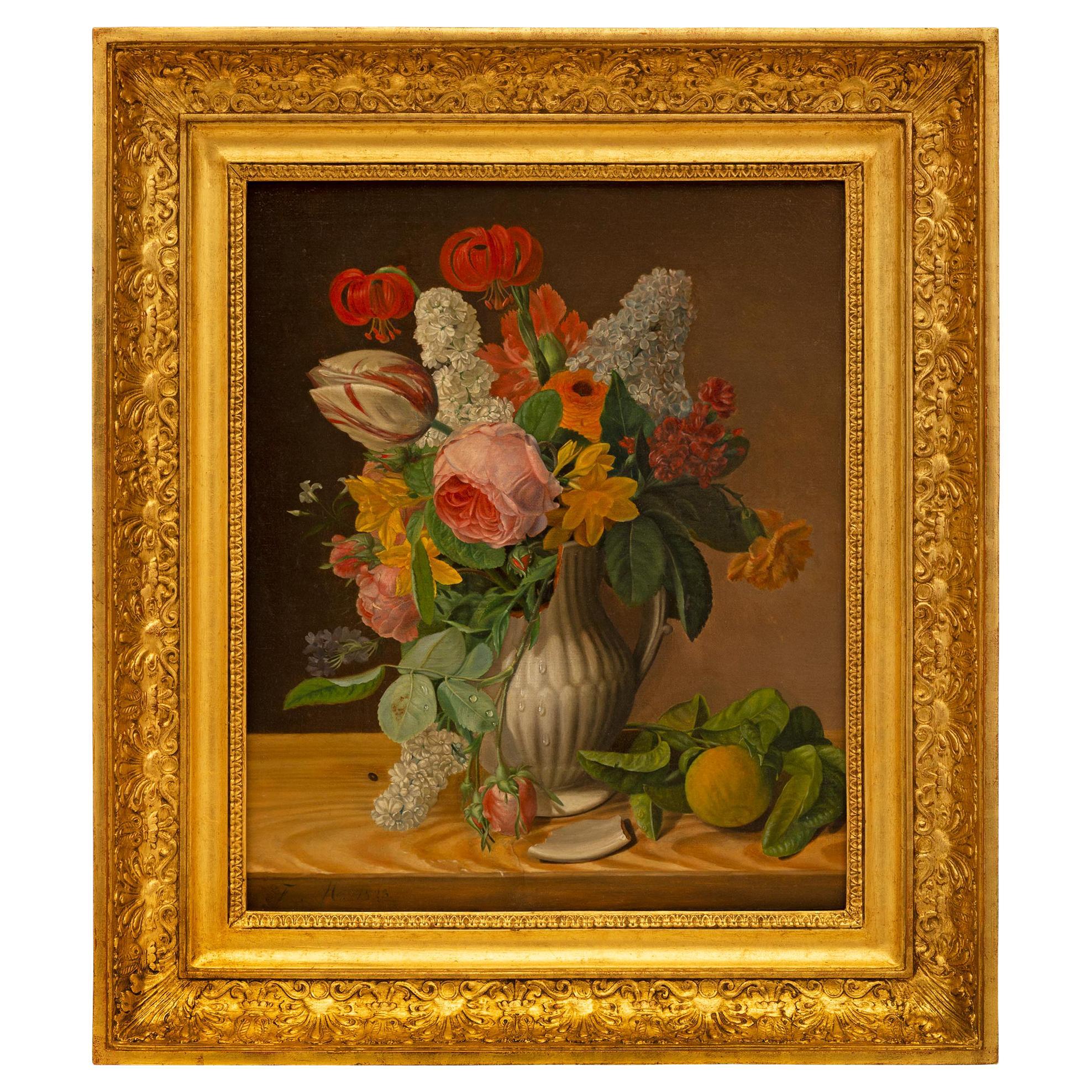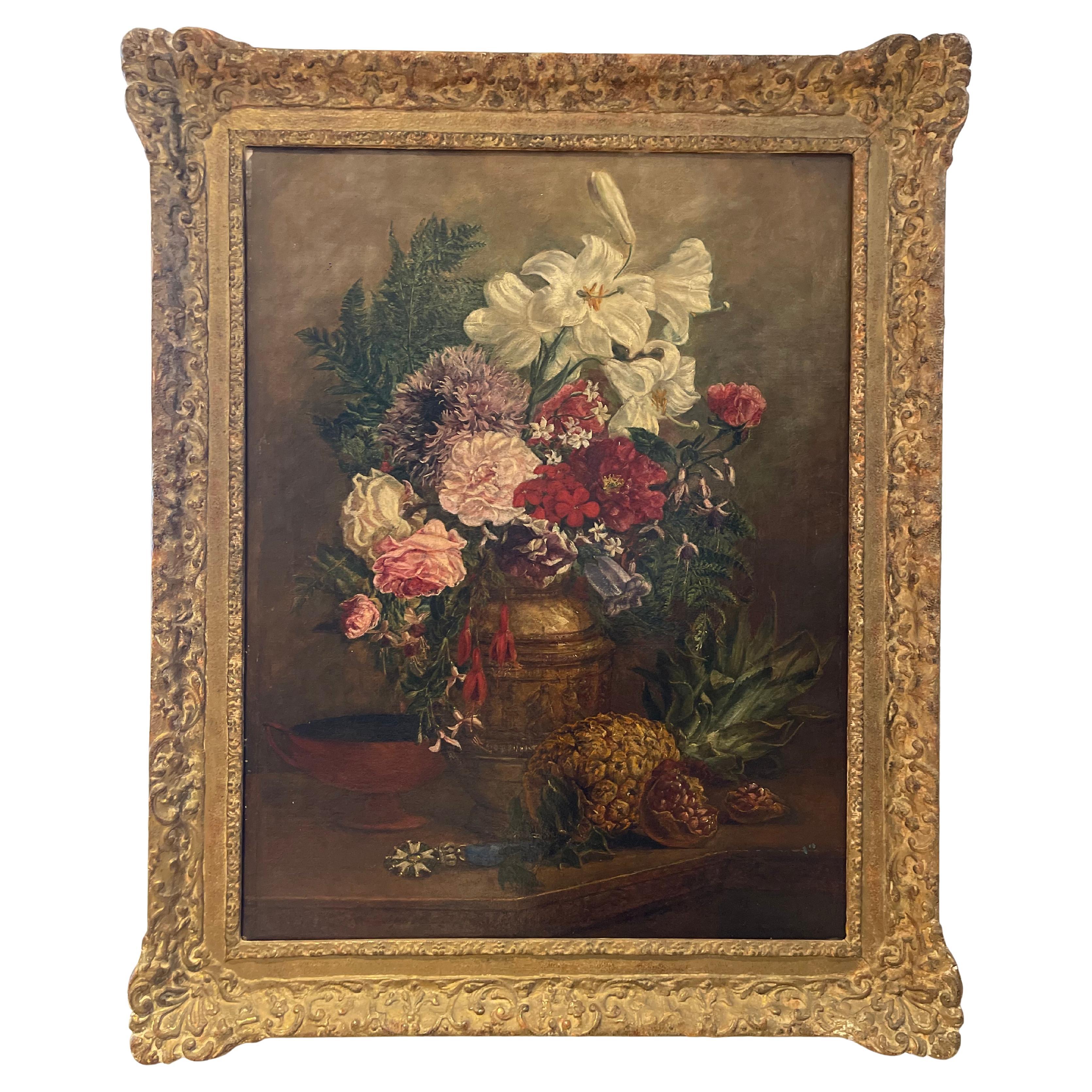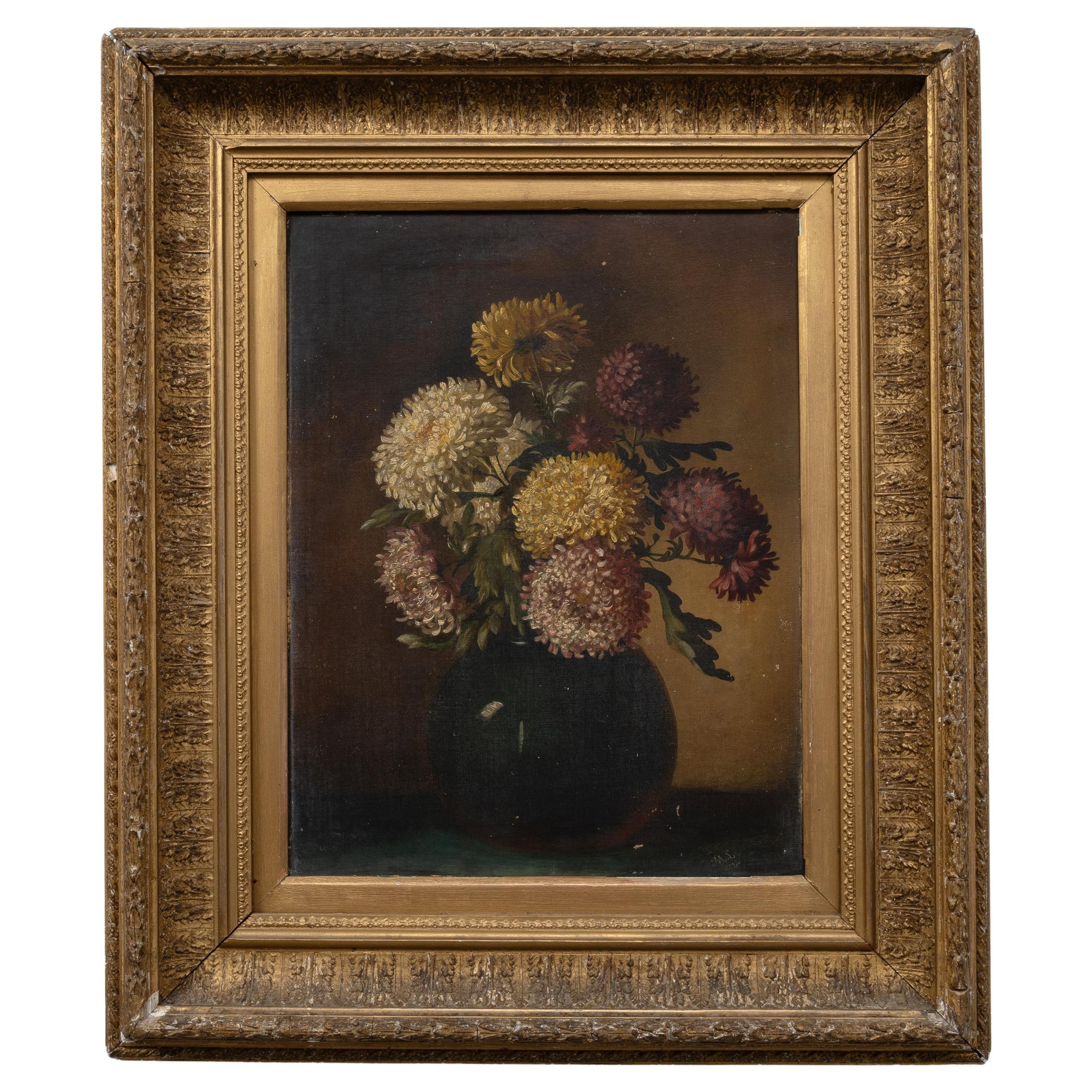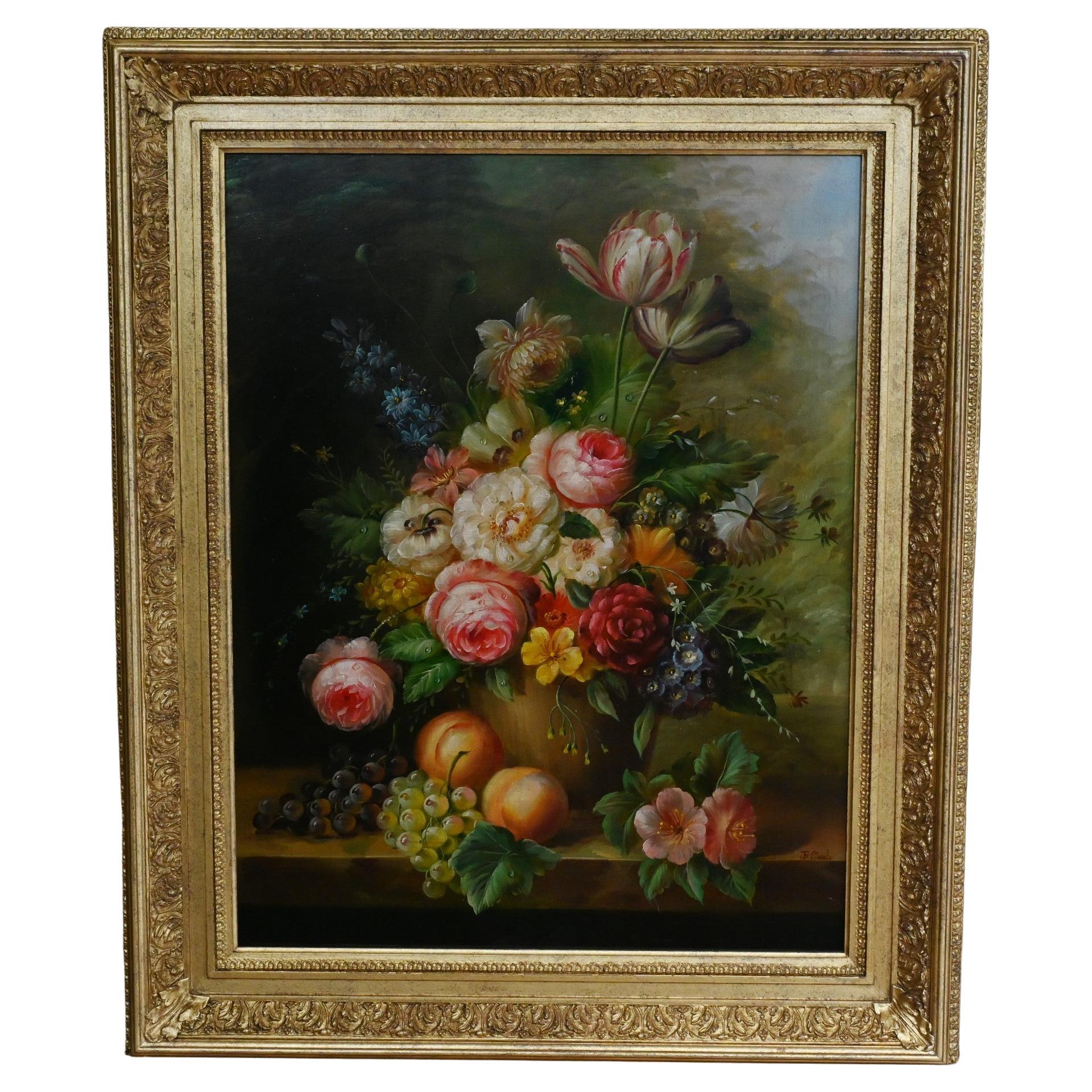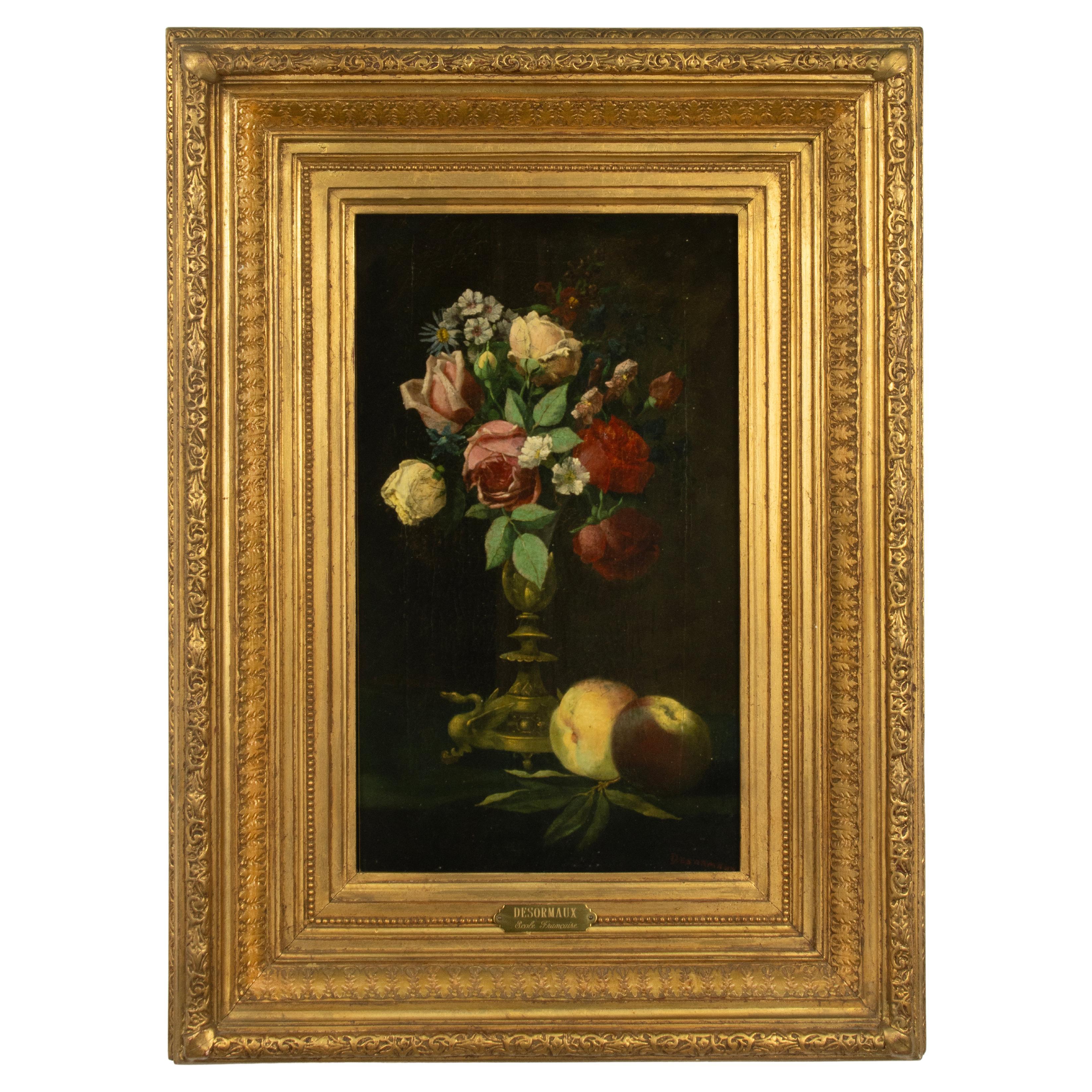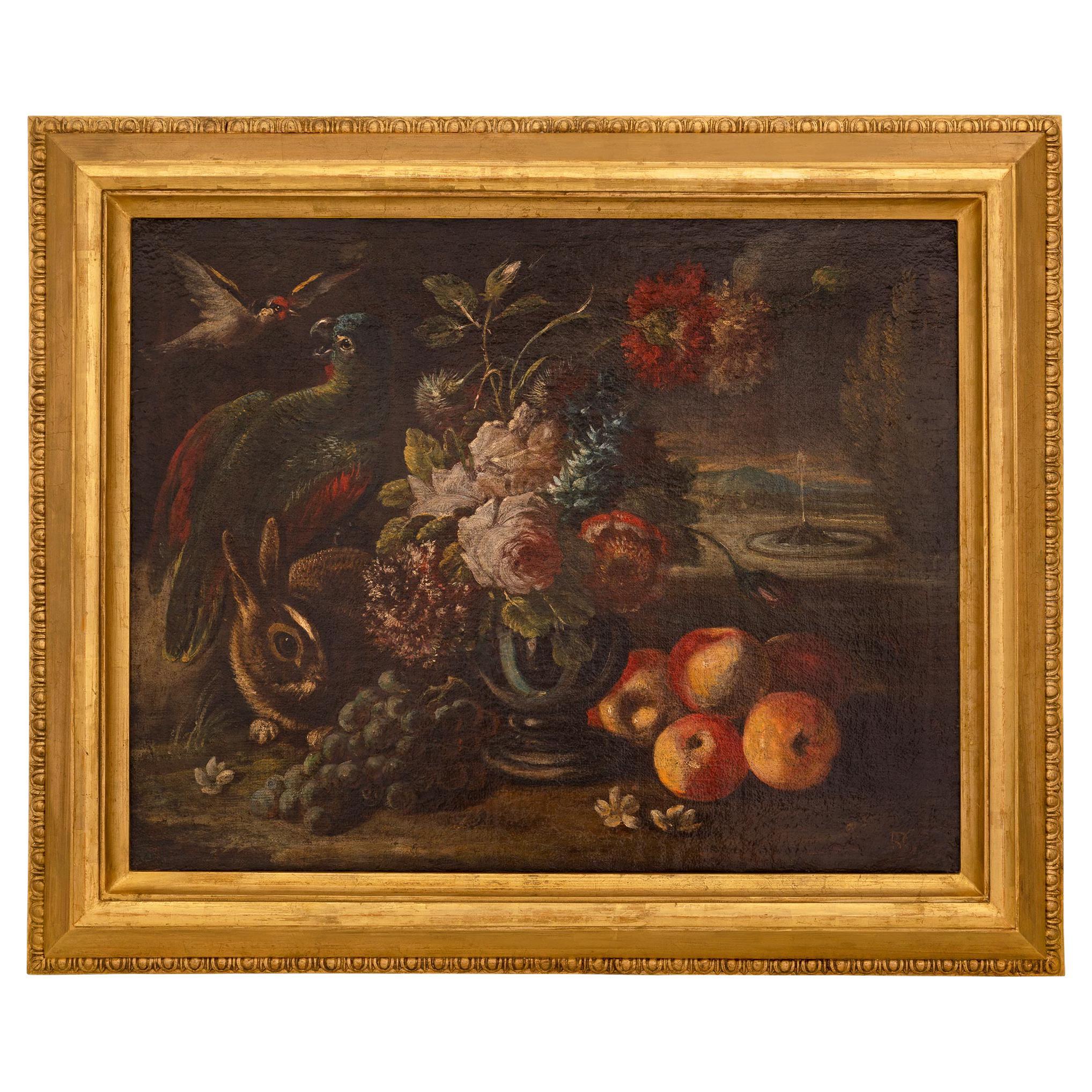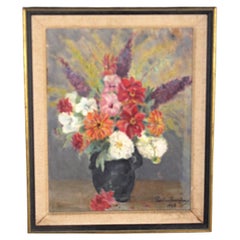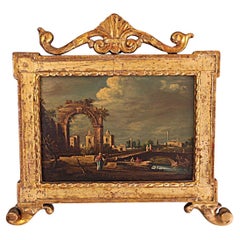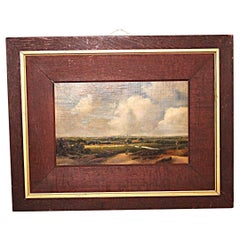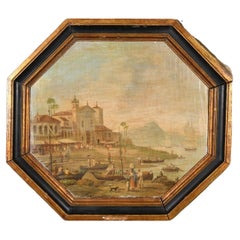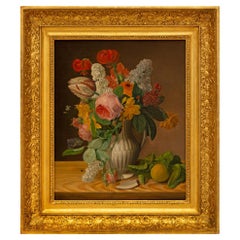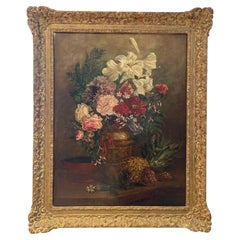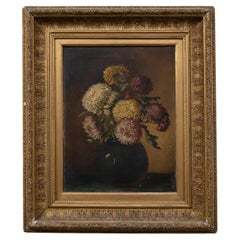Items Similar to Exquisite 19th Century English Still Life of wild flowers– Oil on Wood Panel
Want more images or videos?
Request additional images or videos from the seller
1 of 13
Exquisite 19th Century English Still Life of wild flowers– Oil on Wood Panel
$1,072.47
£790
€926.13
CA$1,476.80
A$1,652.81
CHF 865.19
MX$20,078.61
NOK 10,985.66
SEK 10,366.85
DKK 6,910.52
About the Item
A captivating and finely executed 19th-century English still life painting, rendered in oil on wood panel, depicting an abundant bouquet of mixed flowers in a terracotta urn. This highly decorative piece is a masterclass in Victorian naturalism, demonstrating remarkable precision, rich coloration, and compositional harmony.
Key Features:
Medium: Oil on wood panel
Date: Circa mid to late 19th century
Origin: English School
Dimensions (framed): Approx. 70 x 60 cm
Frame: Set in a deeply carved, original giltwood frame with floral and foliate motifs, enhancing the opulence of the composition.
Artistic Description:
This lush still life showcases a profusion of blooms, including peonies, poppies, roses, clover, delphiniums, and wildflowers, all meticulously arranged in a rustic urn set atop a wooden ledge. The artist’s attention to botanical detail and subtle modulation of light brings a vibrant yet soft naturalism to the work. The dark ground creates a dramatic contrast, making the colours of the flowers burst with life and clarity.
The palette, dominated by soft creams, pinks, reds, and greens, is balanced and restrained, while the cracks in the aged varnish reveal a beautiful craquelure, adding character and authenticity.
Condition:
The painting is in very good antique condition with stable craquelure consistent with age. The frame shows some minor wear but remains structurally sound and richly decorative.
Why Collect This Piece:
This still life is more than a decorative accent; it is a refined example of 19th-century English flower painting, perfect for collectors of Victorian art, interior designers seeking an elegant focal point, or enthusiasts of botanical artwork. Its timeless beauty and historic charm make it a standout feature in both traditional and contemporary interiors.
- Dimensions:Height: 16.93 in (43 cm)Width: 14.97 in (38 cm)Depth: 1.58 in (4 cm)
- Style:High Victorian (Of the Period)
- Materials and Techniques:
- Place of Origin:
- Period:
- Date of Manufacture:1880
- Condition:Wear consistent with age and use. Minor losses.
- Seller Location:Seaford, GB
- Reference Number:1stDibs: LU10376245058692
About the Seller
New to 1stDibs
Joined in the past six months.
No Reviews Yet
Vetted Professional Seller
Every seller passes strict standards for authenticity and reliability
Established in 2021
1stDibs seller since 2025
Typical response time: 2 hours
- ShippingRetrieving quote...Shipping from: Seaford, United Kingdom
- Return Policy
Authenticity Guarantee
In the unlikely event there’s an issue with an item’s authenticity, contact us within 1 year for a full refund. DetailsMoney-Back Guarantee
If your item is not as described, is damaged in transit, or does not arrive, contact us within 7 days for a full refund. Details24-Hour Cancellation
You have a 24-hour grace period in which to reconsider your purchase, with no questions asked.Vetted Professional Sellers
Our world-class sellers must adhere to strict standards for service and quality, maintaining the integrity of our listings.Price-Match Guarantee
If you find that a seller listed the same item for a lower price elsewhere, we’ll match it.Trusted Global Delivery
Our best-in-class carrier network provides specialized shipping options worldwide, including custom delivery.More From This Seller
View AllMidcentury Painting Still Life Of Summer Flowers By Pauline Boumphrey
By Pauline Boumphrey
Located in Seaford, GB
By the American artist Pauline Bomphrey
This midcentury impressionistic oil painting captures a vibrant still life of flowers, showcasing the elegance and charm of purple Delphinium...
Category
Vintage 1950s English Mid-Century Modern Paintings
Materials
Canvas
Antique Venetian capriccio oil painting
Located in Seaford, GB
Francesco Guardi Venice Oil Painting – Venetian Art in the Manner of Guardi
Exquisite 19th-Century Venetian Oil Painting
Experience the timeless elegance of Venetian art with this r...
Category
Early 20th Century Paintings
Materials
Pine, Paint
$1,683 Sale Price
20% Off
Dutch 19th century Landscape Painting
By Andreas Schelfhout
Located in Seaford, GB
This charming oil-on-paper painting captures a serene landscape near Haarlem, evocative of Andreas Schelfhout's masterful Dutch Romantic style. The work features a quintessentially D...
Category
Antique Late 19th Century Dutch Late Victorian Paintings
Materials
Paint, Paper
Early 19th century Capriccio Brazil School Painting
Located in Seaford, GB
Rare Early 19th century Capriccio view of Rio de Janeiro Painting
Probably painted circa 1810 by one of Jean-Baptiste Debret, Italian Students.
Painted on Sailcloth.
Historical Context of Early 19th Century Portuguese Colonial Brazil
1.1 Transition from Colony to Empire
During the early 19th century, Brazil underwent a seismic shift in its political status. Originally a colony under the Portuguese Empire, the arrival of the Portuguese Royal Court in Rio de Janeiro in 1808 rapidly elevated the city’s cultural and political importance. By 1815, Brazil was declared a kingdom united with Portugal, setting the stage for the emergence of the Empire of Brazil in 1822. This period of transformation—often termed the transitional period from colony to empire—fueled a wave of artistic production in cities like Rio de Janeiro.
1.2 European Artistic Influence in Brazil
With the French Artistic Mission in Rio (initiated in 1816) and the presence of various Portuguese and European artists, Brazilian art of the early 1800s began to reflect diverse influences, from neoclassical painting to the early rumblings of romanticism. Painters such as Jean-Baptiste Debret, and Nicolas-Antoine Taunay, and local luminaries like Manuel de Araújo Porto-Alegre contributed to the fine arts tradition in Brazil. Their works featured scenes of local life, portraits of Brazilian society, and imaginative vistas—sometimes referred to as “capriccios,” in which real elements were combined with artistic liberties to create an idealized panorama.
1.3 Rio de Janeiro as Cultural and Political Hub
Rio de Janeiro, often called the Imperial capital after Brazil’s independence, was home to foundational institutions like the Imperial Academy of Fine Arts (Academia Imperial de Belas Artes). Later evolving into the Escola de Belas Artes (School of Fine Arts in Rio), these academies nurtured the talents of emerging painters, who found patronage under the Royal Court and, subsequently, the Imperial Court. The city’s significance was further enhanced by the construction of significant buildings, the modernization of infrastructure, and the mingling of European courtly customs with the traditions of local inhabitants.
. Description of the Octagonal Oil on Canvas: A Capriccio View of Rio de Janeiro
2.1 Composition and Layout
The most striking characteristic of this 19th-century Brazilian art piece is its octagonal shape, a relatively unusual format that draws the viewer’s gaze toward its centre. The composition showcases Rio de Janeiro’s shoreline in the early 1800s, brimming with merchant ships and smaller boats anchored near the shore. On the sand, there is a bustling crowd of local people—men and women carrying food and goods on their heads, loading and unloading boats, and engaging in everyday commerce. The backdrop of soaring mountains suggests Rio’s iconic topography, embodying the landscape that famously defines the city.
2.2 Architectural and Religious Landmarks
On the left side, one can discern the silhouette of a church believed to be Santa Lucia, a significant religious structure in the heart of early 19th-century Rio. This element provides viewers with a tangible reference point, linking the scene to an actual location. However, because this painting is labelled as a “capriccio,” the artist might have taken creative liberties by rearranging or amplifying certain features of the city. The melding of real and idealized elements is characteristic of these imaginative vistas.
2.3 Evoking Daily Life in Colonial Rio
One of the painting’s greatest appeals lies in its portrayal of daily life during the colonial era. Men and women from various backgrounds populate the scene. Some appear to be carrying goods on their heads, a common practice in Brazil that has persisted through different centuries. Others appear to be haggling or trading near small vessels, revealing the commercial pulse of an active port city. This focus on local people, combined with the grandeur of merchant ships, captures the tension and synergy between the every day and the extraordinary—a hallmark of Brazilian colonial painting that balances the grand narratives of empire with the rhythms of ordinary life.
2.4 An Amalgamation of Neoclassical and Romantic Influences
Although academic art in early 19th century Brazil was highly influenced by neoclassicism, the onset of romanticism can be spotted in the emotional portrayal of the sky, the lively palette, and the dramatic emphasis on nature’s beauty (the mountains, in particular). This duality reflects the fine arts tradition in Brazil during the transitional phase when artists were embracing multiple styles. As part of the School of Rio or the Rio de Janeiro school, painters often integrated academic techniques learned from European masters with emerging local subjects and influences.
3. Institutions and Artistic Movements
3.1 Imperial Academy of Fine Arts
Originally known as the Royal School of Sciences, Arts, and Crafts, the Imperial Academy of Fine Arts in Rio de Janeiro was instrumental in shaping 19th-century Brazilian art. Influential artists and teachers from Portugal, France, and other European nations congregated at the Academy, imparting their expertise to native students. As the monarchy consolidated power, the Academy enjoyed royal patronage, leading to the creation of Imperial Academy-style works that combined European academic rigour with Brazilian-themed subject matter.
3.2 Impact of the French Artistic Mission
The French Artistic Mission, which arrived in 1816, played a pivotal role in introducing advanced European artistic techniques, thereby elevating the overall quality of painting in Brazil. Artists like Jean-Baptiste Debret not only documented Brazilian society but also spearheaded the development of a local visual identity that aligned with both academicism and the national context of a blossoming empire. Debret, alongside others such as Nicolas-Antoine Taunay, mentored Brazilian artists, sowing the seeds of what would become the Brazilian academic art movement.
3.3 Religious, Historical, and Landscape Paintings
In addition to everyday scenes and historical compositions, religious iconography remained crucial throughout Portuguese colonial and imperial Brazil. Churches were omnipresent in cityscapes like Rio de Janeiro. Many colonial-era Brazilian portraits...
Category
Antique Early 19th Century Brazilian Spanish Colonial Paintings
Materials
Canvas
$2,925 Sale Price
20% Off
Early 19th century horse painting
By Dean Wolstenholme
Located in Seaford, GB
A Timeless Depiction of the English Fox Hunt
The early 19th-century fox hunting scene, attributed to Dean Wolstenholme Elder, is a stunning representation of the aristocratic traditi...
Category
Antique 1810s English Regency Paintings
Materials
Canvas
English School 19th Century Country House Landscape Oil Painting
Located in Seaford, GB
19th-century painting of Warlies House, Essex
This captivating mid-19th-century oil on panel painting exemplifies the idyllic charm of pastoral landscapes from the period, featuring...
Category
Antique 1870s English Victorian Paintings
Materials
Paint
$2,117 Sale Price
20% Off
You May Also Like
Continental Mid 19th Century Still Life Oil on Canvas Painting
Located in West Palm Beach, FL
A charming and most decorative Continental mid 19th century still life oil on canvas painting in its original giltwood frame. The painting depicts a lovely finely detailed bouquet of...
Category
Antique 19th Century Unknown Paintings
Materials
Canvas, Giltwood
French 19th Century Still Life Oil on Canvas
Located in Southall, GB
French 19th Century Still life Oil on Canvas. Fruit, Vase, Medal and a spray of Flowers.
Indistinct Signature lower R/H. Follower of Henri Fantin-Latour 1836-1904.
80cm x 65cm.
Category
Antique 19th Century French Paintings
Materials
Canvas
Antique English 19th Century Oil On Canvas Still Life Flowers
Located in London, GB
Antique English 19th Century Oil On Canvas Still Life Of chrysanthemums in a vase.
Signed 'M.L' 1889.
Gilt framed.
In good condition, showing some signs of wear commensurate of age.
...
Category
Antique 19th Century English Victorian Paintings
Materials
Paint
$6,299 Sale Price
20% Off
Victorian Floral Still Life Oil Painting Flower Spray
Located in Potters Bar, GB
Absolutely stunning Victorian style still life floral oil painting
So vivid and bright would add light and energy to any room
Brush work so detailed and the choice of colours works s...
Category
Vintage 1980s Victorian Paintings
Materials
Canvas
19th Century Oil Painting - Flower Still Life - French School
Located in Casteren, Noord-Brabant
A beautiful antique painting, a flower still life with roses against a dark background.
On the back is an old label, which states that the painting was possibly made by a painter nam...
Category
Antique 1850s French Paintings
Materials
Paint
17th Century Oil on Canvas Still Life Painting, in a 19th Century Giltwood Fram
Located in West Palm Beach, FL
An exceptional Continental late 17th century oil on canvas still life painting, in a 19th century giltwood frame. The beautiful painting displays a wonderful array of vivid colors an...
Category
Antique 17th Century Unknown Paintings
Materials
Canvas, Giltwood
More Ways To Browse
Mid Century Carved Wall Panel
Mid Century Poppy
Victorian Clover
Curtis Jere Chrome Sculpture
Danish Dog
Diamond Inlay Chest
Dollar Pattern
Drop Front Walnut Secretary
Eileen Gray Lacquer
Francois Gerard
French Bulldog Art
French Primitive Cabinet
French Rococo Bed
Furniture Polish For Birdseye Maple
Georgian Chest On Stand
Green Giraffe
Hand Painted Bed Queen
Hexagon Game Table
